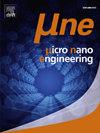金植入硅选择性蚀刻:可行性和纳米制造能力
IF 3.1
Q2 ENGINEERING, ELECTRICAL & ELECTRONIC
引用次数: 0
摘要
硅纳米制造在先进电子、光子和量子器件的发展中起着至关重要的作用。聚焦离子束(FIB)铣削广泛用于纳米尺度的直接图案化,但它需要高离子影响,导致加工时间长,材料再沉积和污染增加。在这项工作中,我们展示了一种基于fib的替代方法,该方法依赖于金离子注入,影响显著降低,实现了选择性硅蚀刻,同时最大限度地减少了这些缺点。将金离子(Au+)以35kev的动能注入到硅衬底中,然后在四甲基氢氧化铵(TMAH)中进行湿法刻蚀。我们确定了Au影响的过程窗口在1 × 1015和1 × 1017离子/cm2之间,通过二次离子质谱(SIMS)确认了维持蚀刻电阻所需的3.5 × 1020原子/cm3的Au浓度阈值,该值也通过蒙特卡罗模拟(TRIDYN)预测。这种方法可以制造最小宽度为36纳米,厚度为20纳米,长度可达8 μm的悬浮硅纳米线,实现超过400的长宽比,以及更复杂的悬浮结构,如网,可用于纳米机电系统(NEMS)的应用,其纳米线宽度在俯距上可降至2%。该方法是传统硅图像化的一种有前途的替代方法,显著降低了加工复杂性,同时提高了纳米结构分辨率。该结果为离子注入辅助蚀刻机制提供了新的见解,并扩大了硅纳米结构制造的可能性。本文章由计算机程序翻译,如有差异,请以英文原文为准。

Silicon selective etching by gold implantation: Feasibility and nanofabrication capabilities
Silicon nanofabrication plays a crucial role in the development of advanced electronic, photonic, and quantum devices. Focused ion beam (FIB) milling is widely used for direct patterning at the nanoscale, but it requires high ion fluences, leading to long processing times, material redeposition, and increased contamination. In this work, we demonstrate an alternative FIB-based approach that relies on gold ion implantation at significantly lower fluences, enabling selective silicon etching while minimizing these drawbacks.
Gold ions (Au+) were implanted into silicon substrates with a kinetic energy of 35 keV, followed by wet etching in tetramethylammonium hydroxide (TMAH). We identified the process window of Au fluences between 1 × 1015 and 1 × 1017 ions/cm2, with secondary ion mass spectrometry (SIMS) confirming an Au concentration threshold of 3.5 × 1020 atoms/cm3 necessary to sustain etching resistance, value predicted also by Monte Carlo simulations (TRIDYN). This approach enables the fabrication of suspended silicon nanowires with a minimum width of 36 nm, a thickness of 20 nm, and lengths up to 8 μm, achieving aspect ratios exceeding 400, as well as more complex suspended structures likes nets which can be targeted for applications in nanoelectromechanical systems (NEMS) reaching nanowire width over pitch down to 2 %.
The proposed method presents a promising alternative to conventional silicon patterning, significantly reducing processing complexity while enhancing nanostructure resolution. The results provide new insights into ion-implantation-assisted etching mechanisms and expand the possibilities for silicon nanostructure fabrication.
求助全文
通过发布文献求助,成功后即可免费获取论文全文。
去求助
来源期刊

Micro and Nano Engineering
Engineering-Electrical and Electronic Engineering
CiteScore
3.30
自引率
0.00%
发文量
67
审稿时长
80 days
 求助内容:
求助内容: 应助结果提醒方式:
应助结果提醒方式:


